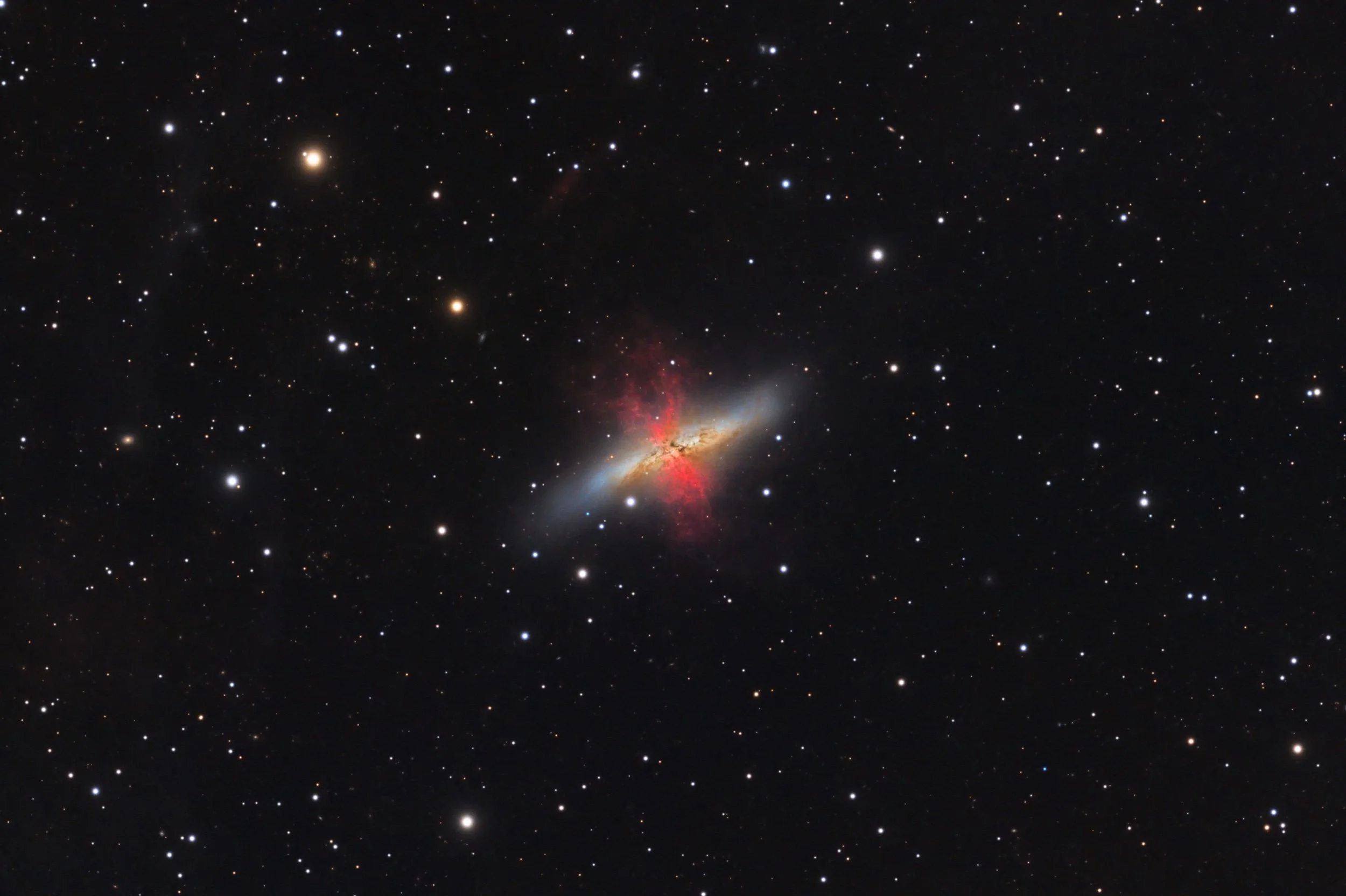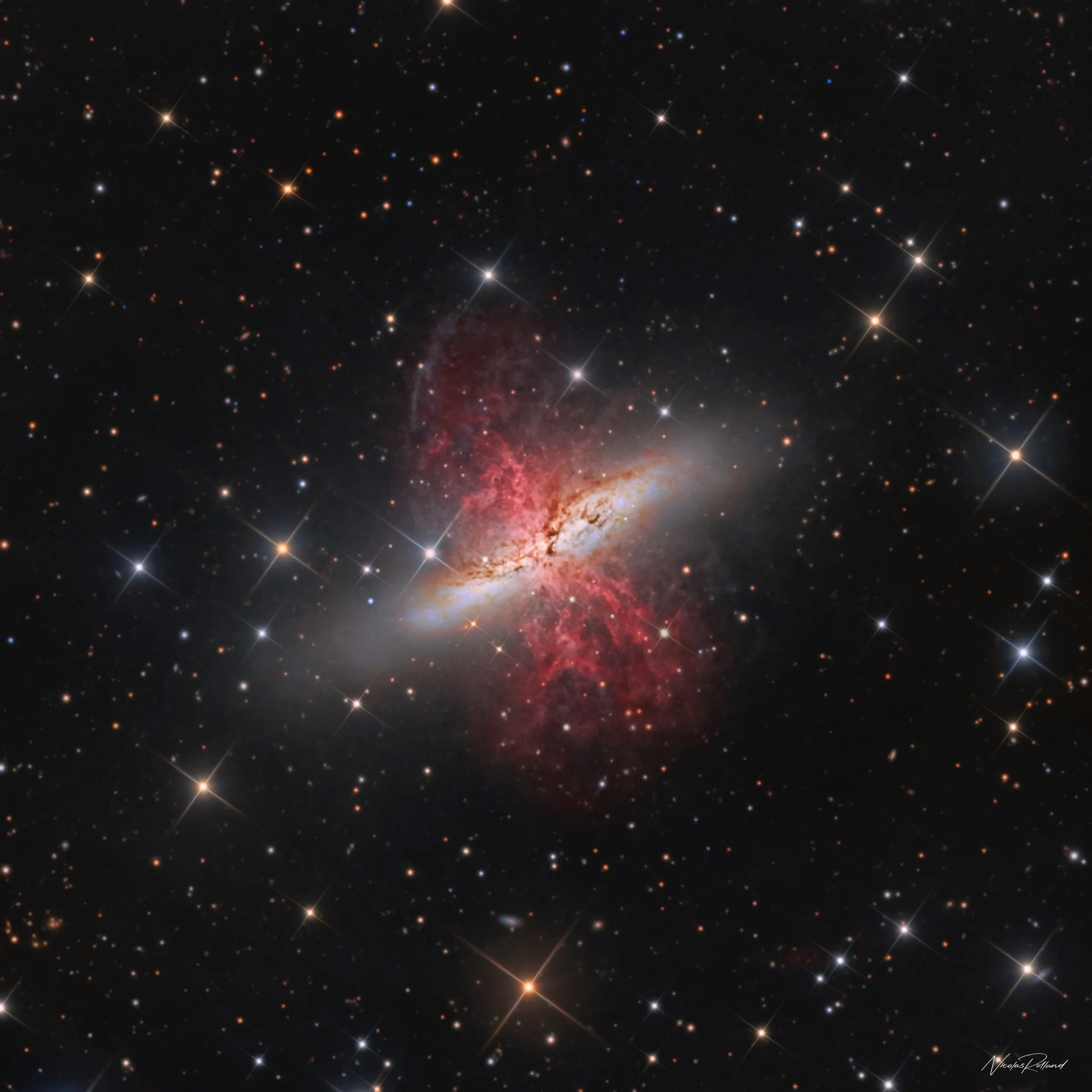
AAPOD2 Image Archives
m82
Featured Astrophotographer on AAPOD2
m82, Cigar or butterfly?
The Cigar Galaxy, known as M82, is a striking starburst galaxy located approximately 12 million light-years away in the constellation Ursa Major. Captured in remarkable detail, this image showcases the galaxy’s turbulent core, where intense gravitational interactions—primarily with its neighbor M81—have triggered a frenzy of star formation.
A defining feature of M82 is its powerful superwind, a result of energetic stellar processes ejecting gas and dust perpendicular to the galaxy's plane. This outflow is highlighted by reddish filaments of ionized hydrogen (H-alpha), which stretch far into intergalactic space. In narrowband imaging, especially in the H-alpha and OIII bands, these filamentary structures become more prominent, offering insights into the dynamic processes shaping the galaxy.
M82 hosts one of the brightest supernova remnants ever recorded, SN 2014J, which became visible to amateur astronomers in 2014. This event provided crucial data for understanding Type Ia supernovae and measuring cosmic distances. Additionally, observations in X-ray wavelengths have revealed that M82's core likely harbors a hidden intermediate-mass black hole, adding further intrigue to its dynamic environment.
M82's edge-on orientation reveals its intricate dust lanes and bright star-forming knots, contributing to its chaotic and vibrant appearance. Despite its compact size, this galaxy is a powerhouse of stellar birth, producing stars at a rate ten times higher than the Milky Way.
M82 – A Deep Integration of the Cigar Galaxy
M82, commonly known as the Cigar Galaxy, is a starburst galaxy located approximately 12 million light-years away in the constellation Ursa Major. As a key member of the M81 Group, M82 is undergoing intense star formation, likely triggered by gravitational interactions with its massive neighbor, M81. This activity results in powerful winds that expel filaments of ionized gas, making the galaxy’s bright core and dramatic H-alpha outflows some of its most striking features.
This deep image of M82 was captured using two different telescope setups over multiple years. An initial 30 hours were collected with a Celestron EdgeHD 800 at 2000mm f/10 paired with an ASI294MM, while an additional 82 hours were acquired this year using a SharpStar SCA260 at 1300mm f/5 with an ASI2600MM. Due to interference from overhead power lines, luminance data was not used, as it prominently showed unwanted artifacts. Instead, only RGB and H-alpha data were integrated, with narrowband exposures effectively enhancing the dramatic outflows of ionized gas streaming from the galaxy’s core. Of the total 112 hours of imaging, the best 101 hours were selected, allowing for an exceptionally detailed rendering of M82’s turbulent structure and energetic starburst activity.
M82
The beautiful starburst galaxy M82 is located in the constellation Ursa Major. It was discovered in 1774 by German Astronomer Johann Elert Bode. Bode also discovered nearby M81, also known as Bodes Galaxy.
M82 is undergoing a huge amount of star formation in its core and due to this massive star formation, emits large amounts of hydrogen gas, seen here in red HII light. A possible theory is that gravitational interactions are occurring with the close neighboring galaxy, M81, and are causing this massive star formation to occur.
Also within the image is a bow shock like feature, called the CAP, which is above M82 and near the top of the image. It's a faint red area of HII emission. This feature was discovered in the late 90's and published in 1999. You can find the paper here. A great discussion about this massive amount of material streaming from M82 can be found here: ap130704.html. There are also a bunch of faint background galaxy clusters in the background and if you look at the high res image you can see them in the background.
M82 is approximately 12 million light years distant and about 1/2 the size of our Milky Way galaxy. M82 shines at an apparent magnitude of 8.4.
The image is a LRGB and Ha composite. I started imaging M82 in April of 2021 and finished in January of 2022. It was shot at 1x1 binning at an image scale of .64 arcsec/pixel. To get a high resolution view of M82, click on the image above.
Image Details
Optics : Stellarvue SVX 152T refractor @f8 1200mm FL
Mount: Paramount MYT
Camera: ZWO ASI6200
Filters: Chroma 50mm LRGB, Astrodon 50mm 5nm Ha
Exposure (min): LRGBHa 366:185:200:200:1120 34.5 hrs, 1x1 binning 1/2 frame
Automation Control: The Sky X, Voyager, PrimaluceLab Eagle 4
Guiding: StarlightXpress Lodestar X2
Processing Software: PixInsight, PS CC, Topaz Labs
Location: Stark Bayou Observatory, Ocean Springs, MS
Sky: Typical SQM 19.6-20.1, Bortle 5, Suburban
Date: 25April - 26 May 2021, 14 Nov - 13 Jan 2022
The Cigar Nebula - Messier 82
Image Description and Details : Messier 82 is the very first galaxy I was able to observe with the naked eye with my old telescope: a C9.25 EDGE HD on a Losmandy G11 Gemini mount. This was in early January 2014, when the supernova SN 2014J was visible. It was also the first galaxy I photographed in May 2017. So it was a great pleasure to have been able to process the data of this galaxy from a much more ambitious setup.
Messier 82 (the Cigar Galaxy) is a starburst galaxy, meaning that it has an exceptional rate of star creation compared to most galaxies. It’s located approximately 12 million light-years away in the constellation of Ursa Major. About five times brighter than the Milky Way, the intense star formation activity was triggered by an interaction with the neighboring galaxy M81.
OPTICS Planewave CDK17 @ F/6.8
CAMERA FLI Proline 16803
MOUNT Paramount ME
FILTERS Ha, L, R, G, B
LOCATION Dark Sky New Mexico, Animas, New Mexico, USA
DATE January 2022 & 2017
EXPOSURES 46 hours (L 58 x 1200 sec, R 28 x 900 sec, G 27 x 900 sec, B 28 x 900 sec, Ha 12 x 1800 sec)
PROCESSING SOFTWARE Pixinsight, CCDstack, Photoshop
Copyright: Data acquisition: Bernard MILLER
Processing: Nicolas ROLLAND
M81, M82, & the Integrated Flux Nebula
Image Description and Details :
Bode's Galaxy, the Cigar Galaxy, and the Integrated Flux Nebula January 6 - January 28 2022 Rowe, NM 305mm Riccardi-Honders @ f/3.8 AP1100 GTO AE Mount, Unguided QHY600PH monochrome @-20*CChroma 50mm x 50mm filtersHaLRGB66.3 hours total integration time
Copyright: Jared Willson
M81 & M82
Well, a first version has already been made with the IFN (Integrated Flux Nebula) processing, clouds of cosmic dust located between the galaxies, specifically this is intergalactic dust that in the background give a somewhat dirty appearance to the image, but they are that, cosmic dust from space, composed of particles smaller than 100 µm.
OBSERVATORY REMOTE FARLIGHTTEAM:
Takahashi FSQ-106 f/5 530mm
CCD QSI 683ws8
Mount 10 Micron 1000
Rotator Pegasus-MGPBox-PowerBox-Armadillo Focuser - Lunatic Zerodew
Voyager software - MountWizar - PixInsight - Adobe PS
Luminance 90 shots of 900 (22`5 hours)
Halfa 56 shots of 900 (14 hours)
Halfa 16 takes of 1200 (5 and a half hours)
RGB 12 shots for each 600 channel (2 hours for each channel in RGB)
Total 48 hours of lights
Darks 60 x900 "+ 60x1200" + 60x600 "
Bias 202
Flats 60xL + 60xHa + 60xR + 60xG + 60xB
Copyright: Jesus Vargas, Marc Valero, Bittor Zabalegui, and José Esteban
M82- The Cigar Galaxy
Image Description:
M82 is also known as the Cigar Galaxy for its elongated visual appearance, it is a starburst galaxy with a superwind. In fact, through ensuing supernova explosions and powerful winds from massive stars, the burst of star formation in M82 is driving the prodigous outflow of material. The filaments extend for over 10,000 light-years. Some of the gas in the superwind, enriched in heavy elements forged in the massive stars, will eventually escape into intergalactic space. Triggered by a close encounter with nearby large galaxy M81, the furious burst of star formation in M82 should last about 100 million years or so. M82 is 12 million light-years distant, near the northern boundary of Ursa Major.
Tech card:
Imaging telescope: Teleskop Service TS 10" RC.
Imaging camera: ZWO ASI294MM-Pro.
Mount: iOptron CEM60.
Guiding camera: ZWO ASI290MM mini.
Focal reducer: Teleskop Service CCD47 0.67x reducer for RC telescopes.
Accessory: ZWO ASIAIR Pro · ZWO OAG · ZWO 8x 1.25" Filter Wheel (EFW).
Frames:
Astrodon Gen2 E-Series Tru-Balance Lum: 20x180" (gain: 120.00) -15C bin 2x2.
Astrodon Gen2 E-Series Tru-Balance Red: 20x180" (gain: 120.00) -15C bin 2x2.
Astrodon Gen2 E-Series Tru-Balance Green: 18x180" (gain: 120.00) -15C bin 2x2.
Astrodon Gen2 E-Series Tru-Balance Blue: 20x180" (gain: 120.00) -15C bin 2x2.
Chroma 3nm Ha: 10x600" (gain: 200.00) -15C bin 2x2.
Total integration: 5.6 hours.
Darks: ~50.
Flats: ~30.
Flat darks: ~30.
Avg. Moon age: 26.66 days.
Avg. Moon phase: 9.26%
Bortle Dark-Sky Scale: 4.00.
RA center: 9h 55' 52"
DEC center: +69° 40' 56"
Pixel scale: 0.707 arcsec/pixel.
Orientation: -95.583 degrees.
Field radius: 0.150 degrees.
Imaging dates: April 8, 2021, April 9, 2021.
Imaging location: Abu Dhabi desert, UAE.
Copyright: Wissam Ayoub
A Cosmic Mess - 80 hours of M81 and M82
mage Description and Details :
This 80-hour image shows a deep look into the area of the two galaxies M81 and M82 and surroundings. The well known Integrated Flux Nebula shows a lot of detail Arp's loop is clearly defined. Another very interesting part were the H-Alpha observations. Nothing new, really, but rarely shown in a field this wide. For one the "Cap of M82". Its a small area of glowing hydrogen next to M82, likely associated with the Starburst.The small galaxy Holmberg IX also showed a lot of hydrogen signal, that's why it almost looks purple instead of the "usual" blue.The image was taken from January through April 2021, in 11 different nights. Roughly 2/3 of the data was acquired from a dark site, the rest in my Bortle 6 Backyard. Image details: 80 hours total integration time 21h Luminance 8h Red8h Green8h Blue35h H-AlphaCelestron RASA8 Skywatcher EQ6QHY 183M Processing mainly done in PixInsight, though some in Photoshop
Copyright: Julian Shroff
M82
Optic RC Ritchey-Chrétien 254 mm / 10" 2000 mm, ASI 1600 MMC.
Exposure time 21 hours LRGB. including 12 hours in H-Alpha.
Location: Germany North Rhine-Westphalia north of the Ruhr area.
Copyright: Dieter Berger
Messier 82 AKA, the Cigar Galaxy
Messier 82 also known as the Cigar Galaxy or NGC 3034 is a starburst galaxy approximately 12 million light-years away in the constellation Ursa Major.
Imaging telescope or lens: Planewave CDK17
Imaging camera: Finger Lakes Instrumenttaion Proline 16803
Guiding telescope or lens: Planewave CDK17
Guiding camera: Starlight Xpress Lodestar X2
Software: PHD2 PHD 2.6.2, PixInsight 1.8 Pisinsight 1.8
Filters: Chroma Blue, Chroma Green, Chroma Red
Copyright: Seymore Stars











